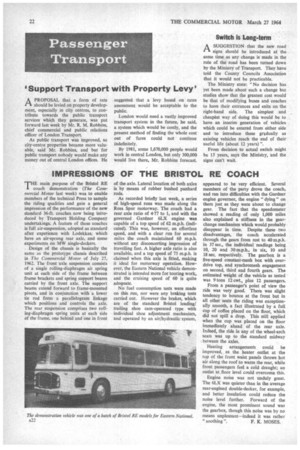IMPRESSIONS OF THE BRISTOL RE COACH
Page 24

If you've noticed an error in this article please click here to report it so we can fix it.
THE main purpose of the Bristol RE coach demonstration (The Commercial Motor last week) was to enable members of the technical Press to sample the riding qualities and gain a general impression of the performance of the new standard 36-ft. coaches now being introduced by Transport Holding Company undertakings. A feature of these coaches is full air-suspension, adopted as standard after experience with Lodekkas, which have an air-sprung rear axle, and some experiments on MW single-deckers.
Design of the chassis is basically the same as the prototype chassis described in The Commercial Motor of July 27, 1962. The front axle suspension consists of a single rolling-diaphragm air spring Unit at each side of the frame between frame brackets and spring support beams carried by the front axle. The support beams extend forward to frame-mounted pivots, and in conjunction with a tower tie rod form a parallelogram linkage which positions and controls the axle. The rear suspension comprises two rolling-diaphragm spring units at each side of the frame, one behind and one in front of the axle. Lateral location of both axles is by means of rubber bushed panhard rods.
As recorded briefly last week, a series of high-speed runs was made along the Ross Spur motorway. The coach had a rear axle ratio of 4.77 to 1, and with the governed Gardner 6LX engine was capable of a top speed of 62 m.p.h. (indicated). This was, however, an effortless speed, and with a clear run for several miles the coach maintained 60 m.p.h. without any disconcerting impression of travelling fast. A higher axle ratio is also available, and a top speed of 75 m.p.h. is claimed when this axle is fitted, making it ideal for motorway operation. However, the Eastern National vehicle demonstrated is intended more for touring work, and the cruising speed of 60 is quite adequate.
No fuel consumption tests were made on this run, nor were any braking tests carried out. However the brakes, which are of the standard Bristol leading/ trailing shoe cam-operated type with individual shoe adjustment mechanism, and operated by an air/hydraulic system, appeared to be very efficient, Several members of the party drove the coach, and ran into difficulties with the Gardner engine governor, the engine " dying " on them just as they were about to change gear. The fact that the speedometer showed a reading of only 1,000 miles also explained a stiffness in the gearchange mechanism which would probably disappear in time. Despite these two disadvantages, the coach accelerated through the gears from rest to 40 m.p.h. in 37 sec., the individual readings being 10, 20 and 30 m.p.h., in six, 10 and 18 sec, respectively. The gearbox is a five-speed constant-mesh box with overdrive top, and synchromesh engagement on second, third and fourth gears. The estimated weight of the vehicle as tested was 9 tons 12 cwt., plus 12 passengers.
From a passenger's point of view the ride was very good. There was slight tendency to bounce at the front but in all other seats the riding was exceptionally smooth, a fact illustrated by a full cup of coffee placed on the floor, which did not spill a drop. This still applied when the cup was placed on the floor immediately ahead of the rear axle. Indeed, the ride in any of the wheel-arch seats was up to the standard midway between the axles.
Heating arrangements could be improved, as the heater outlet at the top of the front waist panels throws hot air along the roof to warm the rear, while front passengers feel a cold draught; an outlet at floor level could overcome this.
Engine noise was not unduly great. The 6LX was quieter than in the average rear-engined double-decker, for example, and better insulation could reduce the noise level further. Forward of the engine, the most prominent sound was the gearbox, though this noise was by no means unpleasant—indeed it was rather "soothing ". F. K. MOSES.




































































































